Defence
Chinese Navy Is Mastering Long-Range Aircraft Carrier Operations — Why It Matters For India
Prakhar Gupta
Aug 11, 2025, 12:51 PM | Updated Sep 01, 2025, 03:34 PM IST
Save & read from anywhere!
Bookmark stories for easy access on any device or the Swarajya app.

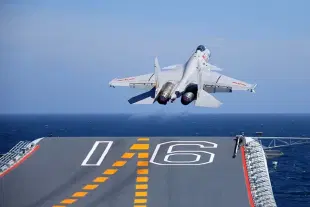
When China commissioned its first aircraft carrier, Liaoning, in 2012, the People’s Liberation Army Navy (PLAN) was entering a domain where India had decades of experience. The Indian Navy’s first carrier, INS Vikrant, had been operational since 1961, and by the time China acquired the refurbished Soviet-era hulk that became the Liaoning, India had already cycled through multiple carriers and carrier-borne aircraft generations.
At that time, Beijing’s first steps at sea were tentative. Its lone carrier was more a symbol of ambition than a battle-ready asset. Barely a decade later, the tables have turned. China now operates two active carriers, the Liaoning and the domestically built Shandong, with a third, the 80,000-ton supercarrier Fujian, in advanced trials.
More importantly, the PLAN’s carrier operations have moved from limited training in home waters to complex, long-range deployments in the Western Pacific, pushing well beyond the First Island Chain and, for the first time, past the Second Island Chain. In terms of scale, range, and operational tempo, China’s carrier arm is maturing faster than most observers could have predicted a few years ago.
Recent Trends
The latest indication of this growing maturity came in June 2025, when the Liaoning and Shandong carrier strike groups conducted coordinated far-seas drills in the Western Pacific. The exercises were part of the PLAN’s annual routine training programme, but they set three important milestones with clear strategic implications.
First, the PLAN deployed two carrier strike groups simultaneously beyond the First Island Chain for the first time.
The Liaoning entered the Western Pacific on 27 May, and the Shandong followed on 7 June. For about a week, the two formations operated just 500 to 600 kilometres apart, close enough for mutual support but far enough to simulate carrier-versus-carrier engagements. The sortie rate underscored the intensity.
The Liaoning launched 90 sorties on 14 June and 80 on 17 June, the highest daily counts of the deployment. This reflects a dramatic rise in capacity over the past two years. In May 2022, the Liaoning generated about 300 aircraft and helicopter sorties in an entire exercise, whereas by April 2024 the Shandong exceeded 600 sorties in a single drill.
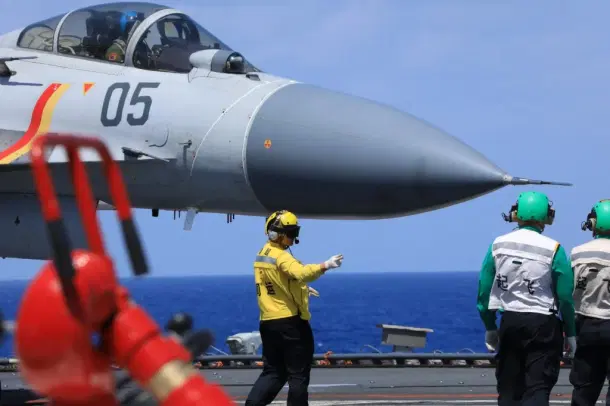
Second, the Liaoning sailed beyond the Second Island Chain for the first time, operating near Minami-Tori-shima, an isolated Japanese coral atoll in the northwestern Pacific Ocean, before moving between the second and third island chains.
This brought Chinese naval aviation within 3,000 kilometres of Midway Island, closer to Hawaii than any previous Chinese carrier operation.
Until May 2024, PLAN carrier-based aviators typically operated within 700 nautical miles of China’s coast. By December 2024, they were ranging out to 1,300 nautical miles, well beyond the comfort zone of land-based diversionary airfields.
Third, the deployment set a new endurance record.
For 27 consecutive days, at least one PLAN carrier group operated beyond the First Island Chain. The Liaoning stayed out for 24 days, matching its previous record from 2021, while the Shandong was active for 16 days, its longest deployment since 2023.
In raw numbers, these milestones may look like incremental progress. However, taken together, they mark a qualitative change. China is no longer experimenting with carriers. It is practising sustained, coordinated, and long-range carrier operations.
Expansion of Operational Geography
Chinese military doctrine draws a sharp distinction between near-seas comprehensive operations and far-seas mobile operations. The former focus on defending China’s immediate maritime periphery, primarily the Yellow, East, and South China Seas, through integrated force use, island defence, convoy escort, and rapid strike.
The latter are about projecting power into “oceanic waters far from land” to control key sea lanes, protect overseas interests, and deter threats far from home.
This expansion is often framed in the “island chain” concept championed by Admiral Liu Huaqing, the architect of the PLAN’s modernisation.
The First Island Chain, which includes Japan and its northern and southern archipelagos, South Korea, Taiwan, and the Philippines, marks the current limit of most PLAN operations. Liu’s long-term vision called for extending activity into the Second Island Chain, from Japan’s archipelago through the Bonin and Marshall Islands to Guam, and eventually even challenging US positions along a notional Third Island Chain centred on Hawaii.
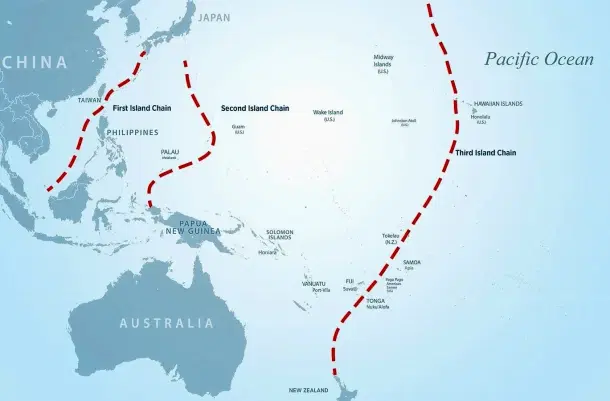
Historically, the PLAN concentrated on near-seas capability, building the muscle memory needed for Taiwan contingencies and regional defence. But the June 2025 drills are strong evidence that the Central Military Commission (CMC) believes this phase is largely complete.
Since August 2022, the PLA has conducted a series of large-scale exercises around Taiwan, refining rapid-response and multi-branch coordination. These have grown shorter in duration but no less intense, suggesting the focus has shifted from proving capability to maintaining readiness.
Now, the training emphasis is shifting outward. Far-seas operations present a different set of challenges. There is no shore-based air cover, longer supply lines, more dispersed formations, and the need for integrated command and control over vast distances. The PLAN’s recent deployments have clearly been designed to test these elements, ranging from high-tempo carrier flight operations to fleet manoeuvring over thousands of kilometres.
The fact that two carriers were deployed together beyond the First Island Chain is especially significant. Coordinating such operations requires complex logistical support, including at-sea replenishment, airborne early warning integration, and deconfliction of airspace and strike packages. These are the building blocks of sustained blue-water capability.
The PLAN’s carrier activity has also evolved in geographic scope. In 2024, most deployments beyond the First Island Chain clustered near the Bashi Channel between Taiwan and the Philippines. In 2025, operations have been more widely dispersed, extending deep into the Philippine Sea and toward the second and third island chains.
This dispersion has two strategic benefits for China. It complicates adversary tracking and targeting, and it allows the PLAN to rehearse operations in varied maritime environments. The June deployment also notably avoided carrier-based flights near Taiwan’s eastern coast, a sign that these drills were less about direct Taiwan signalling and more about refining operational capability in the broader Pacific.
Strategic Implications
For years, Chinese carriers were more political symbols than genuine war-fighting tools. Early deployments were short, close to home, and often timed for diplomatic effect. That period appears to be ending. The PLAN is now integrating carriers into the broader force structure, pairing them with destroyers, frigates, and supply ships in configurations designed for sustained operations.
The Fujian, China’s first CATOBAR (catapult-assisted take-off but arrested recovery) carrier, will accelerate this process once operational. Unlike the ski-jump designs of Liaoning and Shandong, the Fujian’s electromagnetic catapults will allow it to launch heavier aircraft with more fuel and ordnance, extending range and strike power.
This will make far-seas operations more potent, particularly if paired with long-range anti-ship missiles and new airborne early warning aircraft.
China’s third aircraft carrier, Fujian, seen in the public domain for the first time in June 2022, has completed the most technically demanding phase of its sea trials in June 2025, the eighth in the series.
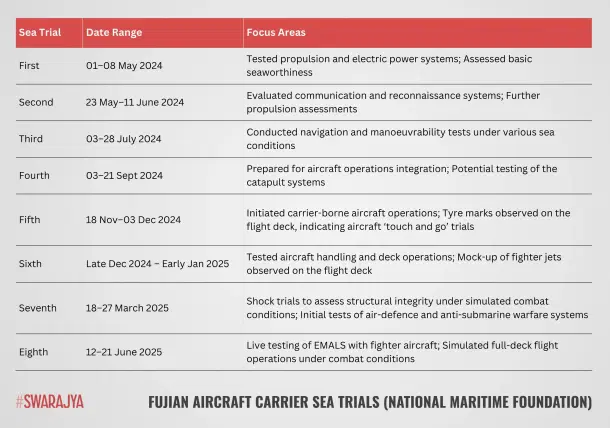
Among other tests, this phase reportedly covered catapult-launch and recovery validation. This capability will allow the PLAN to launch heavier aircraft with full fuel and weapons loads, operate fixed-wing airborne early warning platforms, and sustain higher sortie rates in all weather conditions. It is a generational evolution in carrier aviation, moving the PLAN closer to US Navy standards.
The Fujian’s catapult system is believed to be an electromagnetic launch system similar to the US Electromagnetic Aircraft Launch System (EMALS). It marks a clear technological break from the ski-jump launch method used on China’s earlier carriers.
Unlike ski-jumps, catapults can accelerate heavier aircraft over a flat deck, which expands the variety and capability of the carrier’s air wing.
This includes launching large fixed-wing airborne early warning and control aircraft (AEW&C), which provide much longer radar range and command-and-control coverage than helicopter-based systems. The result is a carrier group with greater reach, better airspace management, and more credible strike capabilities in distant waters.
India’s current carriers, INS Vikramaditya and INS Vikrant, both use the STOBAR (Short Take-Off But Arrested Recovery) system with a ski-jump ramp. While simpler and cheaper to operate, STOBAR limits the maximum take-off weight of aircraft, forcing fighters to launch with reduced fuel or weapons loads.
It also prevents the operation of large fixed-wing AEW&C aircraft, leaving the carrier reliant on helicopters or shore-based surveillance. This restricts the carrier’s operational envelope, particularly in distant waters where shore-based support is unavailable.
Moreover, new imagery also points to progress on the stealthy J-35, China’s next-generation carrier-based fighter. The image shows two J-35s flying in formation and appears to be an official release. Their markings suggest they are early production models for the navy.
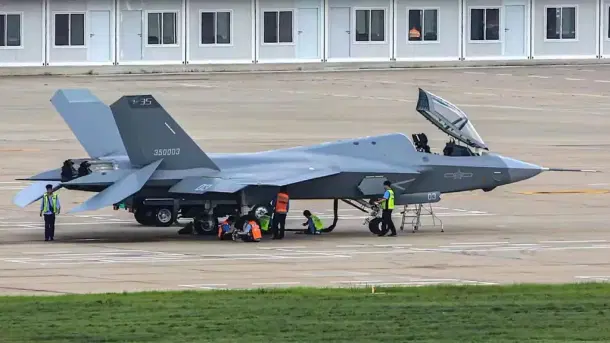
Once the Fujian is commissioned, an event that could take place as early as later this year, the PLA Navy will have a three-carrier force. This will allow it to keep at least one carrier continuously deployed in a chosen region while the others undergo maintenance or readiness training, mirroring the US Navy’s rotation model.
China is also developing its fourth aircraft carrier, the Type 004, which will be significantly larger than the Fujian and the first in its fleet to feature nuclear propulsion. This will give it greater range and endurance, allowing for longer deployments without the need for frequent refuelling. Initial plans suggested completion by the late 2020s, with indications that up to four such carriers could eventually be built.
For now, even with the limitations of its ski-jump carriers, the PLAN is demonstrating that it can sustain a dual-carrier presence in the Western Pacific for weeks at a time. Not long ago, this capability belonged exclusively to the US Navy in this region.
The US and its regional partners cannot ignore these developments. Operating beyond the Second Island Chain brings Chinese carriers within range of Guam, a critical US logistics hub, and begins to extend their reach toward Hawaii. While China is still years away from matching US carrier strike group capability in areas like sortie generation rates, air wing composition, and battle damage resilience, the trajectory is clear.
This growing proficiency may also embolden the PLAN in near-seas encounters. If the CMC believes it has achieved operational dominance in its home waters, it could take a harder line against foreign vessels operating in the East and South China Seas, increasing the risk of unsafe intercepts or brinkmanship.
For India, the shift is a reminder that past experience is no guarantee of present advantage. While the Indian Navy has concentrated on replacing ageing carriers and aircraft, China has rapidly expanded its capacity, infrastructure, and doctrine.
A navy capable of operating carriers deep into the Pacific can just as easily project power into the Indian Ocean. This potential is reinforced by China’s overseas bases in Djibouti and Cambodia, access to facilities in Pakistan, and investments in civilian ports along Africa’s eastern seaboard that offer replenishment points.
At present, the vast majority of China’s fleet is geared for a conflict in the western Pacific rather than an Indian Ocean contingency. However, Chinese security scholars have already floated the idea of a dedicated Indian Ocean fleet, even though one has yet to take shape.
Given the scale and pace of China’s naval modernisation over the past decade, such a development could emerge in the relatively near future.
Projecting power into the Indian Ocean may not currently be the PLAN’s primary mission, but even the limited assets it has deployed there have placed significant strain on the Indian Navy. Any expansion of those deployments would only deepen that pressure.
Prakhar Gupta is a senior editor at Swarajya. He tweets @prakharkgupta.





